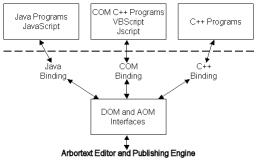Introduction to the Arbortext Object Model (AOM)
The AOM provides object-oriented programming access to Arbortext Editor and Arbortext Publishing Engine. The AOM supports the W3C DOM (Document Object Model) Core and Validation interfaces with extensions, and provides many additional interfaces for Arbortext-specific features that are not part of the DOM. The Arbortext extensions to the DOM use a naming convention where A (for Arbortext) is prepended to the DOM interface name; for example, the Arbortext extension for the DOM Node interface is ANode.
The AOM supports bindings to Java, COM (Component Object Model), and C++. The AOM also provides scripting access to its interfaces using JavaScript, JScript, VBScript, and the ACL (Arbortext Command Language).
The following diagram shows the relationship between Arbortext Editor and Arbortext Publishing Engine, the DOM and AOM interfaces, and programs or scripts accessing the DOM and AOM.
Java programs and JavaScript communicate with the DOM and AOM interfaces using the Java Binding. COM C++ programs, VBScript, and JScript communicate with the DOM and AOM interfaces using the COM Binding. C++ Programs communicate with the DOM and AOM interfaces using the C++ Binding. The DOM and AOM interfaces communicate with Arbortext Editor and the Arbortext Publishing Engine.

